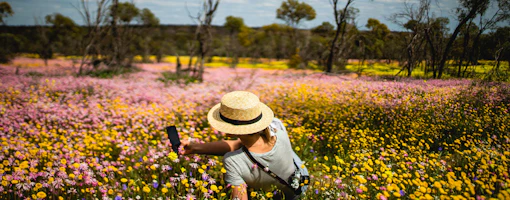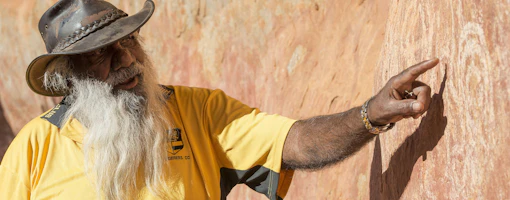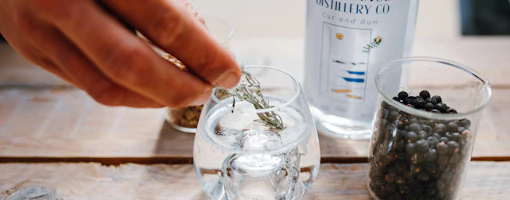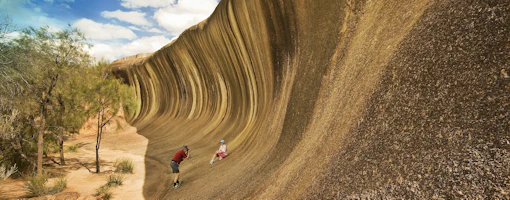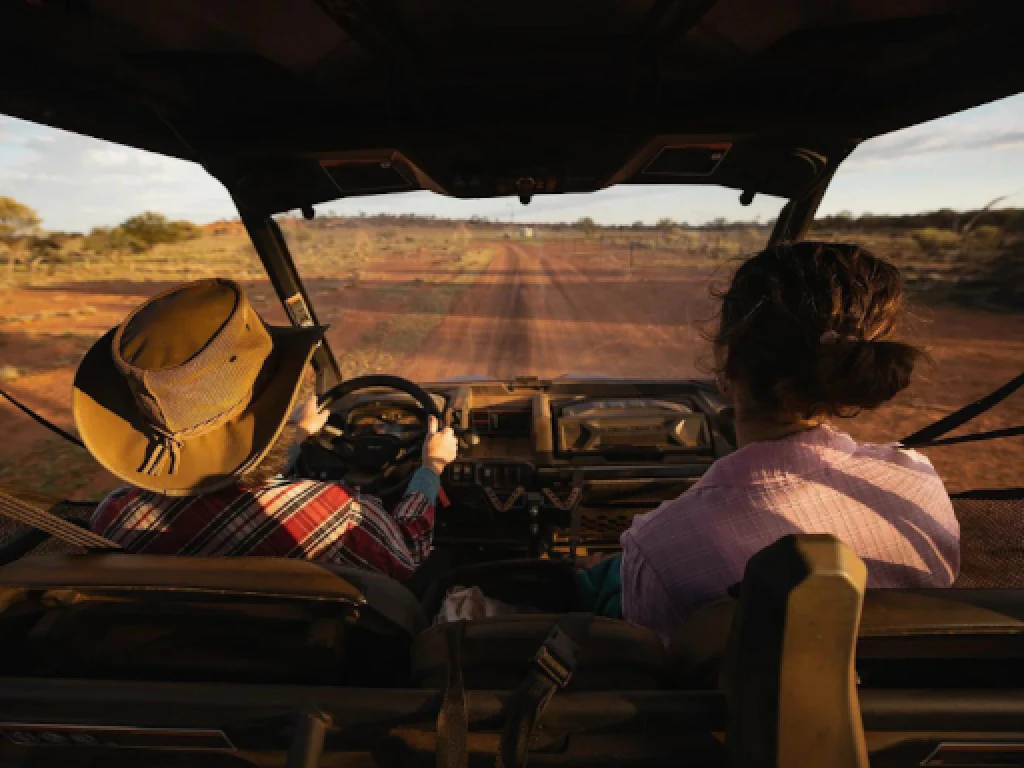
5-days of incredible outback station stays
The station stays of the Golden Outback offer an immersive experience like no other. Carolyn Beasley, Freelance Travel and Environment Writer shares her Station Stay experience with us.
‘The Outback Starts Here,’ the sign proclaims, and proving the point, a red kangaroo soars over a fence and is swallowed by mulga bushland. Together with my family, I’m on a five-day road trip through Australia’s Golden Outback, visiting a number of traditional Western Australian station stays in the Gascoyne Murchison that provide immersive experiences, and a connection to the people who call the outback home.
Day 1 - Mellenbye Station (Closed as of October 2023)

Our first stop is Mellenbye Station, some 400 kilometres north of Perth. Manager Shelly Bogdan has restored the historic homestead, which now includes guest rooms, and the old shearing shed is home to a camp kitchen, dance floor, games and even a mechanical bull (yep, it’s delightfully quirky).
Accommodation includes camping, shearer’s quarters and dongas, but we’ve booked a smart new cottage. With the sky losing its final glow and squabbling galahs on the fence calling a truce, our personal fire pit crackles to life. The stars are impossibly bright, and a giant meteor hurtles towards earth, a stream of light behind it glowing an otherworldly blue.

Highlights here include meeting the pet donkeys and goats, or a visit the station’s granite outcrop for orchids and emus. Shelly says there’s also a place called Breakaway Country. The name inspires me, and we follow Shelly’s farm buggy for 13 kilometres, past the cattle, and paddocks that will later be thick with wildflowers. From a small cliff, we gaze towards a dry lake, and see the salty creek that feeds it during northern cyclones. Over centuries, mighty boulders and chunks of river bank have tumbled towards the creek, these ‘breakaways’ exposing red, white and pink sediments.
Day 2 - Wooleen Station

Farewelling Shelly, we strike north with a stop at Mullewa for supplies (read: bakery pies) before hitting the unsealed Carnarvon-Mullewa road.
Arriving at Wooleen Station, we meet David and Frances Pollock, who are restoring their piece of southern rangelands. Tourism here helps to put food on the table while the Pollocks run their property almost completely destocked for now.
The National Trust-listed homestead with barrel-vaulted roof dates back to 1918, and Frances and David share it with up to 10 guests. Wooleen also has two guest houses and seven wild camping sites. Sixteen kilometres from the homestead, our campsite perches by the casuarina-lined Murchison River.
Day 3 - Wooleen Station
In the morning, we stroll the two-kilometre self-guided walking trail discovering local ecology and Indigenous culture. In the bower bird museum, the station’s original modest dwelling, we inspect station relics like sewing machines, hurricane lamps and typewriters.
We’ve pre-booked David’s popular sunset tour, and pile into his mini-bus. As he drives, David explains the challenges of rehabilitating leasehold land, and the devastating 1930s drought, which still scars this land. We visit the outcrop of Budara Rock, some of the oldest rocks on the planet, where the local Indigenous Wajarri people used a hidden pathway to permanent water. The tour ends on a rocky mountain, savouring a drink with new friends as the final rays of sunshine slide below the biggest horizon imaginable.

Day 4 - Mount Augustus Station
Sunrise finds us departing for Mount Augustus. This mighty rock attracts various superlatives, like the world’s biggest monolith, the world’s biggest monocline and more accurately, an inselberg. Whatever the case, Mount Augustus (Burringurrah in local Wajarri language), is spectacular, remote, and worth the dusty journey.
The rock sits inside a small national park, bordered by Mount Augustus Station, which operates Mount Augustus Tourist Park. Campers here set up around circles of lush grass with shared fire-pits, and we grab basic supplies and fuel here, too. After setting up, we rush out to catch the sunset from Emu Hill Lookout, the perfect place to photograph the rock changing from brown to a fiery red.

Day 5 - Mount Augustus Station
We’re up early making sandwiches, preparing for the 12-kilometre return hike up Mount Augustus. The Summit Trail offers little shade, and although we’re hiking in winter, we’re glad we’ve brought ample water (tip: do not attempt this in hot weather and ensure you’re fully prepared with water and essentials. This is a serious hike). Carefully, we follow the markers at ground level that indicate the trail.
Puffing at the top, we’re elated with the view. We see the station below, and trees delineating the Lyons River, snaking across plain. Descending via the steep, knee-testing Gully Trail, we clamber over large boulders and down dry watercourses.
After recuperating, we tour the base of the rock, feeling privileged to see the ancient Indigenous rock carvings (petroglyphs) that give the place a spiritual atmosphere.
Finally, we take a cooling swim in Cattle Pool (Goolinee). A spinifex pigeon whistles by as I float, and I gaze up through a frame of river red gums, a window to a darkening sky. I realise our station adventure has been a window too, allowing insights into real outback life, with all of its challenges and wonders.
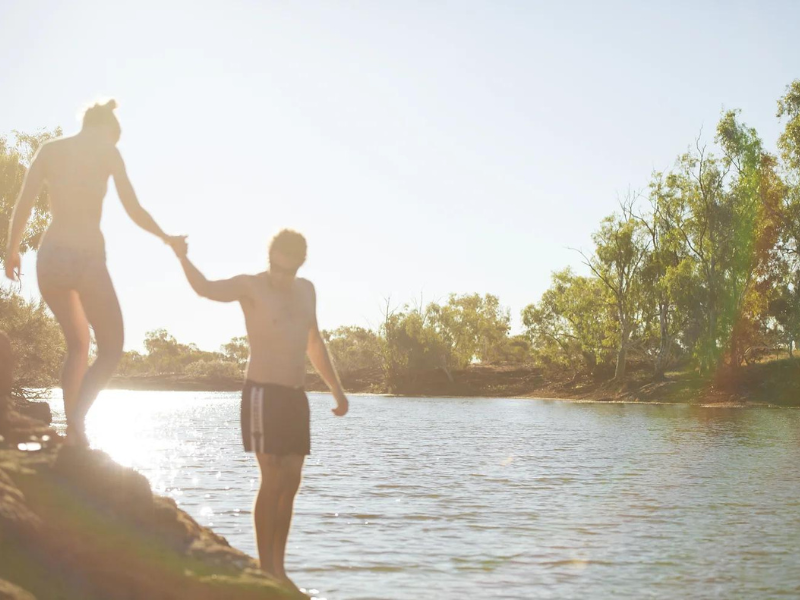
The Gascoyne Murchison is peppered with incredible and unique station stays. Some others to add to your itinerary include:
Melangata Station Stay - 68 kilometres north of Yalgoo. The main drawcard is the grand homestead, designed by the priest and architect, Monsignor John Hawes with tours offered. Book a room with dinner, bed and breakfast, or camp, or sleep in an elegant bell tent. It’s a wildflower hotspot in season, and tag-along tours are available.
Gabyon Station Stay – 60 kilometres northwest of Yalgoo. This working sheep station has been in the same family for over 80 years. Affordable stays are available in the shearer’s quarters, the charming homestead cottage (known as ‘the bull pen’) or in unpowered camp sites. Enjoy outback adventures, like tours on horseback, by motorcycle, hiking, and spotting wildflowers in season.
Nalbarra Station – 98 kilometres north of Paynes Find. Accommodation is in the shearers’ quarters, with most rooms having 24-hour power. Camping sites are available with a communal fire pit and camp kitchen. Go bird-watching, play tennis or take in the wildflowers mid-July to September, phone ahead to learn about wildflowers in bloom or to book a cooked meal.





